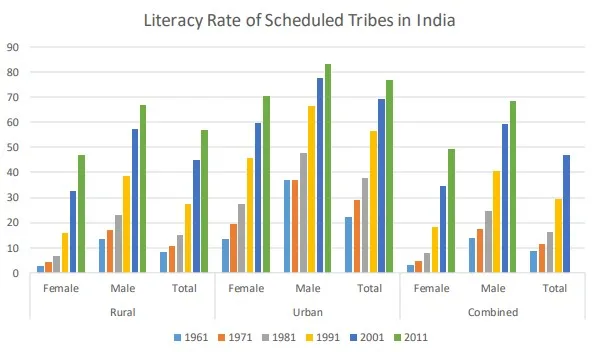Syllabus: GS1/ Society, GS2/ Governance
Context
- The National Human Rights Commission (NHRC), India organized an open house discussion on ‘Tribal Education in India: Problems, Policies and Perspective’ in New Delhi.
Status of Tribal Education in India
- According to the 2011 census, tribes constitute 8.6% of the total population of the country.
- The literacy of the tribe was 8.53% in 1961 which has increased to 58.96% in the year 2011.

Challenges in tribal education in India
- Language Barriers: Tribal children usually speak their native languages at home, which are often not the medium of instruction in schools.
- This language gap makes it difficult for them to understand lessons, leading to poor academic performance and higher dropout rates.
- Early Dropouts: The high dropout rates among tribal students are a significant concern.
- Poverty: The financial instability in many tribal families forces children to contribute to household income through labor, leaving little room for educational pursuits.
- Teacher Absenteeism: In remote tribal areas, teacher absenteeism is a common problem, which significantly hampers the quality of education.
- Poor School Infrastructure: Many schools in tribal areas suffer from inadequate infrastructure, including a lack of basic facilities such as classrooms, toilets, and drinking water.
- Teacher-Student Ratios: Tribal schools often have an insufficient number of teachers, leading to overcrowded classrooms and inadequate attention to individual students’ needs.
Government Policies
- Eklavya Model Residential School (EMRS): It is a central sector scheme introduced in the year 1997-98 to provide quality education to Scheduled Tribes (ST) students (Class 6th to 12th) in remote areas through residential schools.
- Scheme for the establishment of Ashram schools: The Scheme for the establishment of Ashram schools in tribal sub-plan areas is a centrally sponsored scheme for construction of all girls’ Ashram Schools and boys’ Ashram Schools in certain extremism-affected areas.
- States are responsible for the operation and maintenance of these schools.
- National Overseas Scholarship Scheme: Scheme provides financial assistance to 20 students selected for pursuing higher studies abroad for Ph.D. and postdoctoral studies.
- The applications are invited online on the National Overseas Portal.
- The Post-Matric Scholarship Scheme provides financial assistance to ST students pursuing post-matric courses in recognised institutions.
Way Ahead
- There is an urgent need for empirical data, necessitating tribal-centric research in universities to better understand and address specific educational challenges faced by these communities;
- Increasing community engagement and outreach is crucial for improving enrollment rates, while ensuring basic facilities such as drinking water, sanitation, and adequate hostel accommodations, particularly in remote areas, is essential;
- Capacity-building programs for teachers are necessary to sensitize them to tribal cultures and languages, facilitating better communication and understanding;
- Incorporating local languages at the primary level is important for easing comprehension and enhancing the overall learning experience for tribal students.
- Also need to improve tribal representation in higher educational institutions like IITs and IIMs.
Source: PIB
Further Reading: Tribals in India
Previous article
News In Short – 30-08-2024
Next article
Cyclone Asna